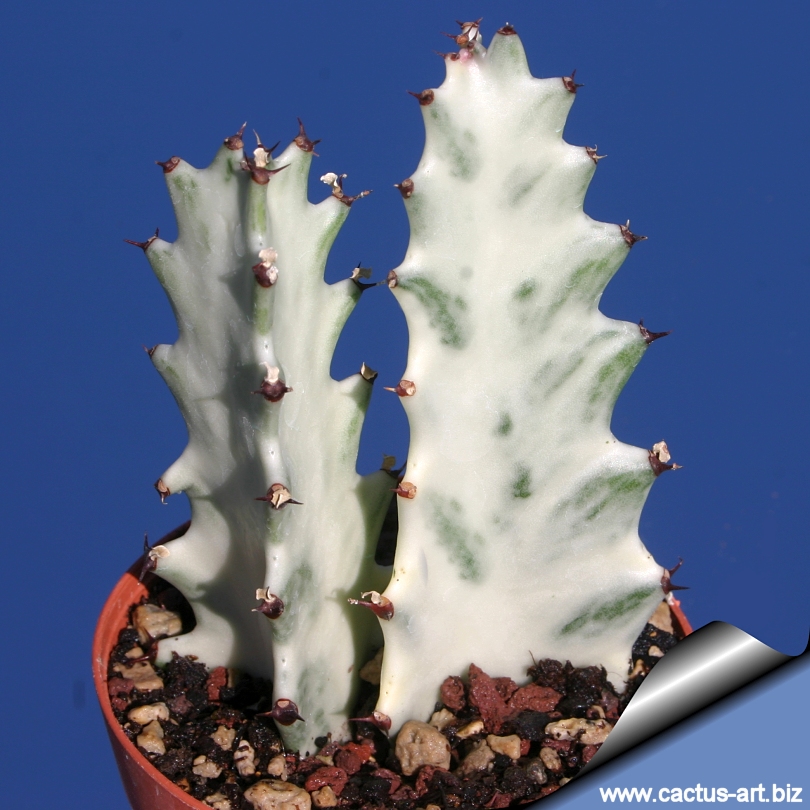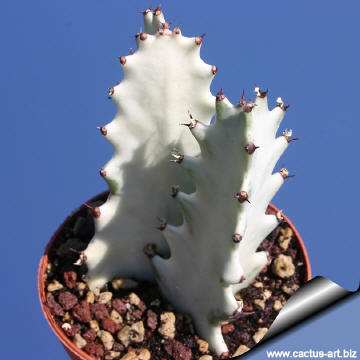|
|
|

Euphorbia lactea cv. WHITE GHOST
This Euphorbia doesn't even look like a real plant and has an
overall creamy white or greyish coloration.
|
|
Description: E. lactea WHITE
(or “Grey”) GHOST is a a striking and very popular cultivar
lacking in most of the chlorophyll bearing tissues of it's green counter
part. This Euphorbia doesn't even look like a real plant and has an
overall creamy white or greyish coloration. Triangular stems grow in
dense candelabra form with distinctive silhouette and grow up to over 3.
Very good in dry indoor situations, it is a much hardier plant than
usually listed that does fine on its own roots. It and can also be grown
outdoors in warmer climate even to full sun, though probably morning sun
would be the most ideal situation. It is a relatively slow grower, at
least compared to the 'regular' form of
E. lactea.
It is a beautiful plant that makes an incredible landscape plant.
Referred to as a “variegated"
"sport”
or "chimeral"
variantit it can be defined as a plant varying from the "norm" that
usually shows some small green patch interpretable as a reversion back
to the green standard form.
Stems: Erect, approx 5 cm in diameter, constricted into oblong
segments.
Ribs: 3(or 4) slightly winged, sinuate.
Leaves: It have have only the tiniest hint of leaves at the
growing tips in summer. The leaves are rudimentary, circular, reddish,
up to 3 mm in diameter, sessile, deciduous,
Stipular spines: Tiny but sharp, paired, widely divergent along
the margins, 2-6 mm long.
|
 |
 |
|
Advertising
|
|
|
|
|
Family:
Euphorbiaceae
Scientific name:
Euphorbia lactea Haworth
In: Synops. Pl. Succ. 127, 1812
CV. White Ghost
Origin: Grows wild, in tropical Asia. Widely cultivated in
west Indies, Florida and in many tropical areas world wide. Widely
escaped from cultivation and in many places forming dense thickets.
Conservation status: Listed in
CITES appendix 2.
Common Names include: Dragoon bones tree, Dragon bones,
Candelabra spurge, Candelabra Cactus, Cactus Candelabre, Caper Spurge,
Candle-stick tree,
Synonyms:
- Euphorbia lactea "GREY GHOST"
|
|
Culture: Euphorbia
lactea is only hardy to maybe 5° C and most grow it either in
pots (excellent potted plant) or plant it in very protected locations.
Euphorbia lactea being from a tropical climate, it is one
of the few columnar Euphorbias that do exceptionally well in very wet,
humid climates. It need bright light to partial shade for best
appearance (but the variegated forms do best if protected from strong
sunshine in the hottest hours of the day). It responds well to warmth,
with its active growth period in the late spring and summer months.
Water thoroughly when soil is dry to the touch during active growing
season (more than once a week during hot weather) In the winter months,
waterigs should be suspended or restricted to once over the winter. The
most common failure in growing this plant is over watering, especially
during the winter months. Likes porous soil with adequate drainage.
Succulent Euphorbias in greenhouses apparently are seldom affected by
fungous diseases.
The Ghost form can be burned in
direct sunlight, though acclimating it to morning sun is not difficult.
This is a slow growing plant, though the cristate forms seem
particularly slow growing. Cristate forms are usually grown as grafted
plants and that may have something to do with their slow growth rate.
Reproduction: It is propagated by cuttings, while the crested
forms are difficult to grow on their own roots, and are generally
grafted for convenience on
Euphorbia canariensis or
Euphorbia resinifera.
It is recommend taking Euphorbia cuttings in Spring/Summer when the
plant is growing so that they have a better chance of success. They key
is heat & good air circulation. These cuttings should be dipped in
Hormone powder (but it is not needed) and left for a period of 3-4 weeks
to callous. Then pot the cutting and don't water ( or kept slightly
moist) until rooted. These will root just fine, if you can put the pot
outside in the summer, or put pot on a heating pad.
Warning: As with all other Euphorbias when a plant get damaged it
exudes a thick white milky sap known as latex. This latex is
poisonous and particularly dangerous for the eyes, skin and mucous
membranes. So pay extreme attention not to get any in your eyes or
mouth. Cultivated plants must be handled carefully.
|
|
|
|
Photo of conspecific
taxa, varieties, forms and cultivars of Euphorbia lactea.


|
|